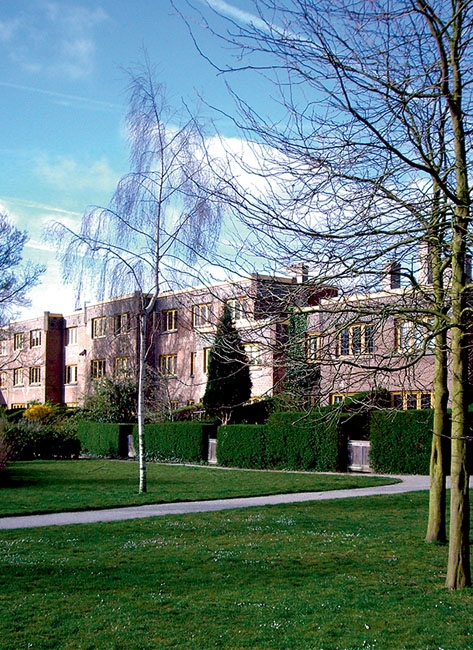Tuinwijk-Zuid Haarlem J.B. van Loghem
DOI:
https://doi.org/10.7480/dash.01.4540Samenvatting
De Haarlemmerhout en de ten oosten daarvan gelegen voormalige buitenplaats Oosterhout werden vanaf het begin van de 20e eeuw geëxploiteerd als villapark. Tuinarchitect Leonard A. Springer maakte in 1900 hiervoor een stedenbouwkundig plan volgens de Engelse tuinstadgedachte. Het voorzag in ruime kavels voor vrijstaande huizen, maar ook in lange aaneengesloten rijen woningen met diepe achtertuinen. De rijenbebouwing was waarschijnlijk nodig om grotere grondopbrengsten te genereren bij een terugvallende economie.
De woningbouwvereniging Tuinwijk, met een sociale doelstelling, gaf in 1918 architect Van Loghem opdracht het deelplan Tuinwijk-Zuid te ontwerpen. Het ging hierbij om gesubsidieerde bouw van middenstandswoningen.
De socialistische ideeën van Van Loghem over gemeenschapszin onder de bewoners en de tuin als bindend element speelden een grote rol bij zijn aanpassingen van Springers ontwerp. Van Loghem hield vast aan het gebogen lanenpatroon, maar hij liet de oorspronkelijke tussenlaan weg en verlengde de Zonnelaan, waardoor er ruimte voor gemeenschappelijke binnentuinen ontstond. Het binnengebied werd verder vergroot door de bebouwde randen dicht langs de straten te situeren en de diepte van de met ligusterhagen afgescheiden achtertuinen terug te brengen tot ongeveer 5 m.
De gedeelde voortuinen vormen een overgangszone tussen openbare straat en privéhuis. Door de beide bouwblokken is een route gemaakt die nagenoeg Springers tussenlaan volgt.
De binnentuinen veroorzaakten onmiddellijk financiële problemen: de te hoge erfpacht leidde bijna tot het faillissement van de vereniging. De suggestie om de binnentuinen alsnog te verkavelen voor meer grondopbrengsten, werd uiteindelijk verworpen, omdat dit het aanzien van het project zou schaden. De tuinen werden vanaf het begin als een sterke kwaliteit ervaren.
Zoals je vaker ziet in tuinsteden, wordt het overbouwen van de doorgangen naar het binnengebied ingezet als een architectonisch middel om stedelijkheid uit te drukken. De Tuinlaan is ter plaatse van deze poortwoningen aan beide zijden verruimd. De poortbebouwing is een verdieping lager dan de aangrenzende woningen. Aan weerszijden van de poorten zijn twee hoge schoorstenen geplaatst die vooral vanuit de binnentuinen een markering vormen.
Het wonen is gericht op de binnentuin. Door de keuken en dienstvertrekken aan de straatzijde te leggen, en de woon- en eetkamer aan de achterzijde, wordt de traditionele plattegrond omgekeerd. In verband met de oriëntatie op het zuiden geldt dit niet voor de huizen aan de Spaarnelaan. Dit woningtype heeft een traditionele en-suite indeling met de keuken aan de achterzijde.
Binnen Tuinwijk-Zuid zijn het vooral de achtergevels van de Tuinwijklaan en Zonnelaan die het waardige aanzicht vormen. Hier zijn de gevels met hun grote identieke ramen rustiger en formeler dan de voorgevels, die vooral door de met hout beklede balkons op de uitspringende bergingen en de pergola’s van de bovenste bouwlaag een sterke plasticiteit bezitten. Om monotone achtergevels te vermijden, heeft Van Loghem hier net als bij de voorgevels een geleding toegepast, door de eetkamers een meter uit te laten springen.
De houten pergola’s aan de voorzijde suggereren, ook door het materiaalgebruik, een soort tuinhuisje op het dak; ze waren bedoeld om te laten begroeien. Als zonnebalkon werden deze ruimtes vanaf het begin al niet veel gebruikt, omdat de meeste bewoners kozen voor het rustige, aantrekkelijke achtergebied.



